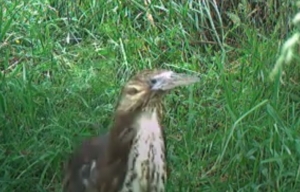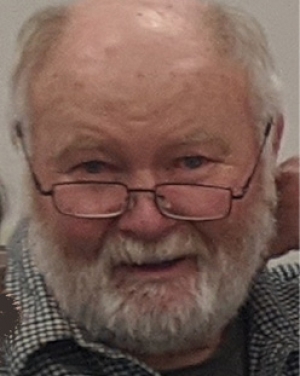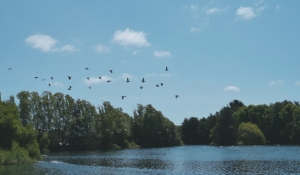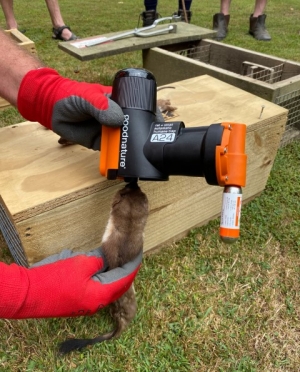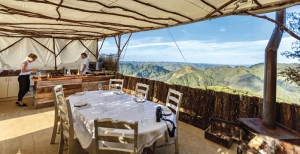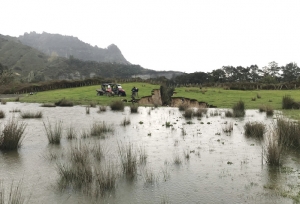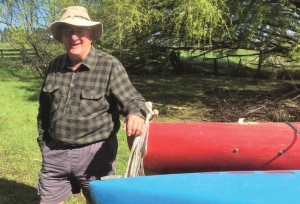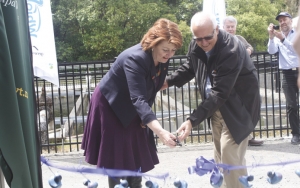Displaying items by tag: Conservation
Elusive Bittern
Elusive Bittern caught on camera at Wairio Wetland
Jessica Wagner is a student at Victoria University of Wellington, researching rat response to scent and acoustic stimuli in the Wairio wetland. The intended outcome of Jessica's research is to determine what stimuli are most attractive to rats in order to improve trapping efforts, and ultimately, to protect rare birds such as the Bittern and wetlands in general.
Jessica was a recipient of one of the wetland care scholarships.
"I was recently going through my footage and noticed that one of my cameras has recorded a video of a Bittern on the 4th of December! I thought that you and others at Ducks Unlimited NZ may be interested in this so I have attached the video below. Feel free to share with anyone else who may be interested" (Jessica) .
New Year's honour for conservation
DUNZ member Mike Bourke has received the Queen's Service Medal (QSM) in the latest New Year's honours for his services to wildlife conservation. The citation for his award says Mike has developed large sections of his family’s farm in Rangiwahia into a wildlife reserve and habitat of more than 30 acres.
He began transforming his farm in the 1970s, fencing off waterways and, with a friend and nurseryman, planted more than 10,000 trees, shrubs and fruit orchards around the farm and surrounding wetlands.
He established Bourke’s Dam (now Mangahuia Wetlands) in 1997 in collaboration with Fish and Game New Zealand, and went on the create two more wetlands.
Mangahuia Wetlands is open to the public through a gate off Main South Road in Rangiwahia, northern Manawatū, but visitors are asked to call Mike on 06 328 2840 first. If he is unavailable, leave a message.
After releasing trout into the wetlands several years ago, he has become involved with Fish and Game’s Take a Kid Fishing Day, helping children learn to fish and providing rods and lures.
He has built several netting houses with the aim of breeding and protecting Carolina wood ducks, pheasants and Californian quail. He has carried out extensive predator control and successfully bred mute white swans, acquiring his first pair in 1973.
He has previously been recognised for his conservation of rare waterfowl and wetland habitat, winning the 2006 PGG Wrightson Habitat Environmental Award.
Congratulations, Mike.
Good neighbours
ISAAC CONSERVATION AND WILDLIFE PARK CENTRE
A short drive from Christchurch Airport is a 1100-hectare block of land where construction, quarrying, concrete and asphalt companies, livestock and salmon farming co-exist with conservation in a unique business model.
The land is owned by the Isaac Conservation and Wildlife Trust, which was formed in 1977 to continue the conservation work of Sir Neil andLady Isaac, Diana, who had ownedand lived on the land. “Their intention was to leave the place in a better condition than they found it,” says trust administration manager Catherine Ott.
In the early 1950s, Sir Neil and Lady Isaac founded Isaac Construction.
The tagline of combining construction with conservation demonstrates the construction company’s commitment to conservation.
Today the successful construction company is one of the leaseholders on the land which provide the income for the land rehabilitation and conservation activities. Catherine says this business model is really important because it means the trust is self-funding and can exist in perpetuity without the need to fundraise. The assured income also allows planning for the future with confidence.
The main focuses of the trust are the conservation of endangered native flora and fauna, conservation of heritage buildings and the study of conservation through education and research.
Peacock Springs, which covers 73 hectares, is the main conservation area where the endangered NZ species are bred for release into the wild. It is off-limits to the public.
The trust has a memorandum of understanding with the Departmentof Conservation who has requestedthat the trust currently focus on fivebird species – whio (blue duck), pateke (brown teal), black stilt (kaki), orangefronted kakariki and the New Zealand shore plover.
The orange-fronted kakariki numbers were desperately low, Catherine says, and though the DOC put them on predator free islands, they didn’t thrive as well as expected. DOC now release them in the south branch of the Hurunui in the Arthurs Pass region where intensive predator control is undertaken. At the time of writing there are thought to be 200 to 300 orangefronted kakariki alive there, however this population could crash at any time. “We have specialised knowledge
garnered over 20 years in the captive breeding for release. Another reason for our success is because we are not open to the public. The aviaries are not designed for display but for breeding, so you may never see a bird.’’
The kakariki thrive best in dense, dense bush. “Our aviaries are so densely planted, when chicks fledge, it can be very difficult to locate them.”
Catherine says Peacock Springs has also focused on waterfowl and wading birds because it has a good source of water running through the aviaries,
encouraging invertebrates such as water boatman that assist the young birds to learn to forage.
The birds are being bred for release into the wild so some of the aviaries are 7 metres high, allowing the birds such as black stilt to build up strength to fly to escape from predators.
Catherine says that although the public are excluded from most of the conservation activities, an area is open to the public on the easternmost boundary except during lambing and other farming operations. The Isaac Loop track and Isaac Farm Walk are easily accessible from Clearwater Golf Course.
“We have retired a significant portion of land beside the Otukaikino stream and fenced it and planted about 50,000 natives along the loop track. We also have a planting programme across other areas of the Isaac site as part of
our quarry reclamation programme to provide stepping stones for birdlife and invertebrates,” Catherine says.
The trust employs 16 to 20 staff, with more needed during the breeding season. Most are skilled with aviculture experience.
Lady Isaac was not just a wildlife conservationist, but also a conservationist of historic buildings.
The development of the Isaac Heritage Village is based around 14 relocated historic Canterbury buildings. Many of these unique and irreplaceable buildings (c1860 to 1940), were threatened with demolition. The village will eventually be open to the public.
Let’s hit them with some tech
DU Director Dan Steele looks at another tool to help in the fight against predators.
The biggest problem with conservation in New Zealand is complacency and believing that someone else is looking after mother nature on your behalf.
So many people leave things to the Department of Conservation and believe that that’s enough.
It’s not, it’s going to take a huge combined effort from many New Zealanders and particularly landowners to slow the decline in our biodiversity caused by these introduced pests.
But it is not easy to start a conservation project, it is usually an extra job for already busy landowners and who pays, how is it going to be maintained and what should be done?
We ran a really good trapping demonstration for our local sustainable farming group last week, the Taumarunui Sustainable Land Management Group.
Mustelid expert Professor Carolyn (Kim) King, of Waikato University, gave a great overview of New Zealand pests, how we got to this point and whether pest-free New Zealand has any hope of success. The jury is still out on this.
But she believes future technology may well make it possible.
We’re trying to demonstrate that it’s quick and easy to set a few traps around the farm; knowing what to do is often the biggest obstacle with farmers. Then of course there is the capital cost to set up traps and the ongoing maintenance. Goodnature, a Wellington pest company founded 13 years ago, is certainly making the setup and the maintenance easy with their well thought-out technology.
The new Chirp feature on their traps provides bluetooth information from the trap direct to your smartphone.
You link your phone to the trap and it logs the GPS coordinates, and when you check the trap, it tells you how many strikes the trap has had and when.
Then once you’re back into cellphone reception or internet connection, the information is automatically uploaded to the cloud onto the Goodnature world map.
Your traps and kills can be viewed by anyone looking at the map – they show up orange.
Cunningly though, when people are viewing your traplines, they can only see to within 150 metres of where you have your traps placed, so people can’t turn up and steal or sabotage your traps. The owner of the traps can however have their GPS coordinates down to a metre or two.
We are finding the A24 Goodnature traps a good way for people to sponsor some traps, to be involved and stay in touch with how the conservation work
is performing.
It’s so important to be holding our ground against predators; this week at Blue Duck Station, we have had a kaka sighting and a report of a bittern booming.
The Goodnature A24 rat and stoat trap automatically kills 24 rats or stoats (and mice) one after the other, before you need to replace the CO2 gas canister. When the pest tries to reach the lure inside the trap, they brush past a trigger which fires a piston, killing them instantly. The piston retracts and resets ready for the next pest. The trap comes with a pump that refreshes the lure automatically for six months. Three different trap kits are available: a trap-only kit, a trap with a counter or a trap with Chirp.
‘The biggest conservation project on Earth’
Dan Steele, the man with the gavel at the yearly DU auctions, headed to Wellington the week after the AGM to play to a different kind of crowd – at Homewood, the home of the British high commissioner, as part of Wellington on a Plate, the city’s month-long celebration of good food.
Dan and UK chef Jack Cashmore teamed up to offer guests a 10-course degustation menu, finishing the meal with a discussion by Dan on conservation, sustainability and a better New Zealand.
Dan said in an interview after the event: “New Zealand could be the biggest conservation project on Earth.
“For me, the big picture is that New Zealand could lead the world in producing quality products which world-class chefs, like Jack Cashmore, want to use in the best restaurants in the world. We can also lead in the realm of biodiversity management and conservation.
“It’s a big ask to get the primary industries on board to work closely together, but if we can pull it off and be recognised as the biggest conservation project on Earth at the same time as continuing to farm, then every product in New Zealand will become more valuable,” he said.
Sharing in his philosophy is Jack, who has worked in two Michelin-starred restaurants and was head chef at Anglo in London. Since meeting almost 10 years ago, Jack and Dan have shared a vision for both the farm and New Zealand.
Their goal is for Blue Duck Station and its pop-up restaurant, The Chef’s Table at Blue Duck Station, which was open last summer, to be the best overnight and fine-dining experience in New Zealand – based on the philosophy of nature conservation and sustainability.
Jack said it was New Zealand’s array of biodiversity, open culture, and sense of community that kept him coming back. Now his second home, Blue Duck Station offers him the chance to build a small restaurant from scratch.
You win some, you lose some
In 2012 a wetland was created at DU Director Dan Steele’s property, Blue Duck Station in the Ruapehu district, but things haven’t gone exactly as planned. Water has tunnelled under the pumice layer – the hills are predominantly pumice – to the next hard layer, first creating an underground leak, which DU’s John and Gail Cheyne noticed during a visit.
Next came the washout: Dan says, “We first noticed pumice floating down the Retaruke River before we found the washout.”
As of publication date, the problem is still waiting for a solution.
Meantime Dan has not been idle but had to climb out of his gumboots for a day or two to head to the city, see The biggest conservation project on Earth.
Trans-Tasman bittern knowledge exchange
Australian wildlife ecologist and bittern expert Matt Herring visited last year and took the time to catch up with his New Zealand counterparts.
“The best thing we can do for nature is simply spend more time in it. From there, reverence grows and action flows.” M Herring, 2013
What a wonderful trip. It was as if we spent a week compiling precious pieces of a rare, incomplete jigsaw puzzle called “Australasian Bittern Ecology and Conservation”.
After several years of being in touch via email and phone, it was so nice to finally get together with the New Zealand bittern crew and see some of their sites first hand.
There is some great work happening across the ditch and a strong sense of being united in working towards reversing the decline of this iconic waterbird that we share. It is affectionately known as matuku hūrepo in Māori, or matuku for short.
The knowledge exchange began with the biennial National Wetland Restoration Symposium in Napier where I was honoured to be a keynote speaker, focusing on the importance of community engagement, novel habitats and active management.
We then had a day visiting wetlands around Hawke’s Bay, including Pekapeka Swamp, followed by a successful bittern workshop day organised by Matt Brady from DOC. It was now crystal clear to me that there’s a lot of love for matuku in New Zealand.
With much discussion about wetland restoration targeting bitterns, it was astounding for many folk to learn about bitterns in rice and how bare, ploughed paddocks ready for sowing are able to support nesting bitterns less than three months later. There was a range of inspiring case studies from around New Zealand at the workshop, and we got to visit some local work in Hawke’s Bay with Hans Rook.
After that, it was time to begin a broader tour of bittern sites across the North Island. First stop was Lake Whatuma, and thanks to John Cheyne and Bernie Kelly, we were able to track some bitterns while kayaking.
We discussed key issues like willow control, raupo (cumbungi) harriers as bittern nest predators.
This wetland has up to nine booming males, but far fewer females, perhaps only three. The apparent shortage of female bitterns across New Zealand is something DOC’s Emma Williams is very concerned about. We may well have the same problem in Australia.
males in rice fields have up to three nesting females in a single territory, there is emerging evidence that would support a general shortage of females here too. It’s definitely something we should consider: a booming male may not be a sufficient indicator of breeding
or site quality.
It was now October and time to visit the 7200-hectare Whangamarino Wetland, between Auckland and Hamilton. This Ramsar site was once the world’s most important wetland for the Australasian bittern, with more than 140 booming males in 1980.
Nowadays, there’s only about a dozen. I learnt about the many issues that are implicated in the decline, such as introduced species and water quality, but I think the huge water level fluctuations are central.
Near Tauranga, we visited the Lower Kaituna Wetland, and were lucky enough to spot a bittern feeding in the eleocharis. Part of the restoration work in the broader area is starting from scratch, essentially constructing new wetlands.
And on the edge of Tauranga itself, right on the coast, we visited a bittern breeding site that was tidal. This was quite perplexing. The vegetation is low and we wondered where they build their nests without being flooded.
Unfledged chicks have been found in land nearby, including a recreational park. We talked about how this site would be suitable for a thermal drone in locating nests and monitoring breeding success.
All in all, a wonderful trip, with special thanks to all who made it possible. I’m looking forward to returning the favour!
The love for matuku in New Zealand is admirable, and the conservation work being done is inspiring
DU directors in the news
DU directors in the news – for good reasons
Two DU directors, John Dermer and Dan Steele made the news this year,
both appearing in mainly rural papers, and both for very good reasons.
Dan Steele - Conservation and tourism with farming
John Dermer – the ultimate Farm Forrester
Conservation Week
Conservation week November 1-9
New Zealand is full of great places and hidden treasures. DOC knows because they manage over 1400 great places, each with its own special appeal.
This Conservation Week DOC is making it fun and easy to get out and explore the great outdoors. They are hosting activities and events around the country. Even if you can’t make it to an event you can encourage some mates to join you in an adventure, tell your friends about somewhere you love to go, or get your kids to be creative.
There is a range of things to do and see so head out with family and friends and explore the great outdoors – it’s fun and easy! Go to www.doc.govt.nz for more information.
Captive Whio and new facility

